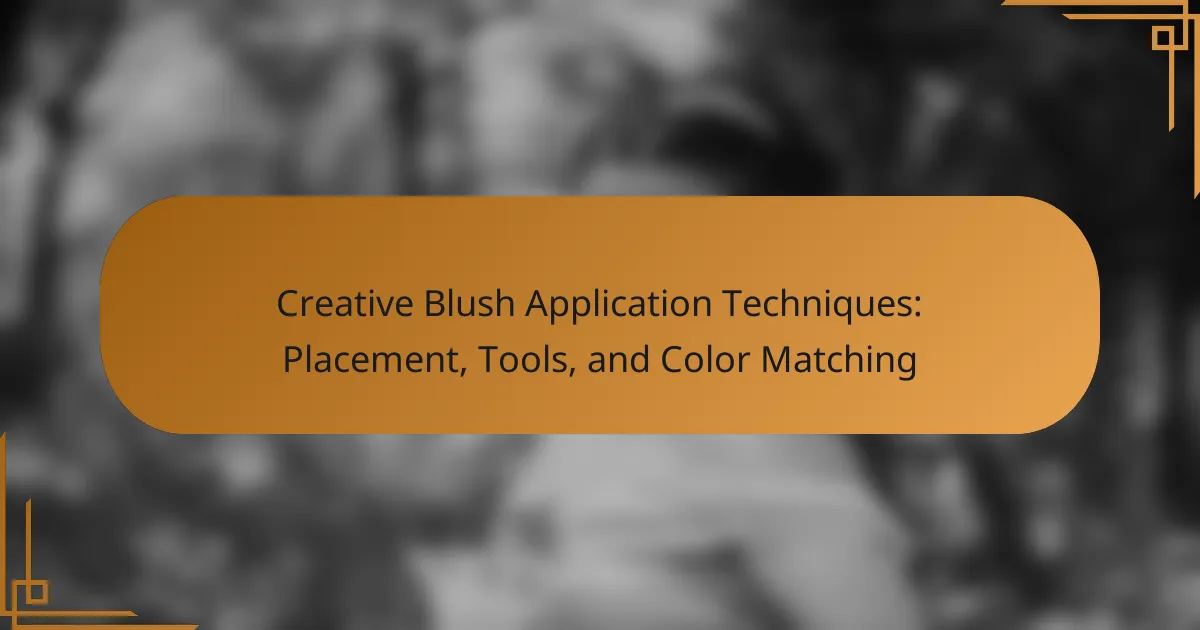Lip makeup techniques encompass various methods for applying products to enhance the lips aesthetically. Key techniques include lining, which defines the lip shape with a lip liner; filling, which involves applying lipstick or gloss for color and texture; and blending, which creates a gradient effect using multiple shades. These techniques can produce different finishes, such as matte, glossy, or satin, significantly affecting the overall appearance and durability of lip makeup. Understanding these application methods and color trends enables individuals to achieve personalized lip artistry tailored to their preferences.

What are Lip Makeup Techniques?
Lip makeup techniques refer to various methods used to apply products on the lips for aesthetic enhancement. These techniques include lining, filling, and blending lip products. Lining involves using a lip liner to define the lip shape. Filling is the application of lipstick or gloss to add color and texture. Blending combines different shades for a gradient effect. Techniques can vary in finish, such as matte, glossy, or satin. Each method can impact the overall look and longevity of the lip makeup. Understanding these techniques allows for personalized lip artistry.
How do different application methods impact lip makeup?
Different application methods significantly impact lip makeup results. Techniques such as using a lip brush, fingers, or directly from the tube create varied finishes and precision. A lip brush allows for detailed application and blending, resulting in a more polished look. Applying with fingers can create a softer, more natural finish, ideal for a casual appearance. Direct application from the tube offers convenience but may lack precision. Each method influences color intensity and longevity. For example, a brush can deposit more product evenly, enhancing color payoff. In contrast, finger application may result in a sheerer effect. Ultimately, the choice of application method affects the overall aesthetic and wear of lip makeup.
What are the most common lip makeup application methods?
The most common lip makeup application methods include using lip brushes, applicators, and fingers. Lip brushes provide precision for detailed application. Applicators, often found in liquid lip products, offer convenience and ease of use. Fingers can be used for a more natural, blended look. Each method has its own advantages based on the desired finish. For example, a lip brush is ideal for bold, defined lines. Applicators are quick for on-the-go applications. Using fingers allows for a softer, more diffused effect. These methods cater to various preferences and occasions in lip makeup.
How does the choice of tool affect the application process?
The choice of tool significantly influences the lip makeup application process. Different tools, such as brushes, applicators, or fingers, produce varying levels of precision and finish. For instance, lip brushes allow for detailed application and contouring, resulting in a more defined look. Conversely, using a finger may create a softer, more blended appearance.
Moreover, the type of product being used can dictate the best tool. Liquid lipsticks often require a precise applicator for even coverage, while balms may be easily applied with fingers. The choice of tool also affects the longevity of the makeup. Brushes can help layer products effectively, enhancing durability throughout the day.
Additionally, tools can impact the overall texture and finish. A sponge applicator might impart a more airbrushed effect, while a stiff brush can create a matte finish. Ultimately, selecting the appropriate tool aligns with the desired outcome of the lip makeup application.
What finishes are available for lip makeup?
Available finishes for lip makeup include matte, satin, glossy, and sheer. Matte finishes provide a flat, non-reflective look. Satin finishes offer a soft sheen without being overly shiny. Glossy finishes create a high-shine appearance, enhancing the lips’ fullness. Sheer finishes deliver a light wash of color, allowing natural lip tone to show through. Each finish caters to different aesthetic preferences and occasions.
What are the differences between matte, glossy, and satin finishes?
Matte, glossy, and satin finishes refer to different surface appearances in lip makeup. Matte finishes have no shine and provide a flat look. They are often long-lasting and highly pigmented. Glossy finishes, in contrast, are shiny and reflective. They create a wet look and can enhance the fullness of the lips. Satin finishes fall in between matte and glossy. They have a slight sheen but are not overly shiny. This finish offers a soft, velvety appearance. Each finish can affect the overall impression of the lip color. For example, matte finishes can convey sophistication, while glossy finishes can suggest youthfulness.
How do different finishes affect the overall look and feel?
Different finishes significantly impact the overall look and feel of lip makeup. Finishes like matte, glossy, and satin each create distinct visual effects. Matte finishes provide a flat, sophisticated appearance. They often convey a bold, modern style. Glossy finishes, on the other hand, add shine and dimension. This finish can make lips appear fuller and more youthful. Satin finishes offer a balance between matte and glossy. They provide a soft sheen without excessive shine. The choice of finish can also influence texture perception. For instance, matte finishes may feel drier, while glossy finishes feel moisturizing. Overall, the finish chosen plays a crucial role in the aesthetic and tactile experience of lip makeup.
What are the current color trends in lip makeup?
Current color trends in lip makeup include bold reds, soft nudes, and vibrant corals. Bold reds are making a comeback, often seen in matte finishes. Soft nudes are popular for a natural look and suit various skin tones. Vibrant corals add a fresh pop of color, perfect for spring and summer. Additionally, deep berry shades are trending for a dramatic effect in fall and winter. These trends reflect a shift towards versatile colors that can be worn across different occasions.
How do seasonal trends influence lip color choices?
Seasonal trends significantly influence lip color choices by aligning with the changing moods and aesthetics of each season. In spring, lighter and more vibrant shades like pinks and corals are popular, reflecting the renewal of nature. Summer often sees bold and bright colors, such as reds and oranges, as people embrace a lively, sun-kissed look. Fall typically brings deeper hues like burgundy and plum, echoing the changing leaves and cooler weather. Winter favors rich and dramatic colors, including dark reds and berries, often associated with holiday festivities. These trends are driven by fashion runways, beauty influencers, and cultural events that dictate popular styles throughout the year.
What are the most popular lip colors this year?
The most popular lip colors this year include soft pinks, deep reds, and [censured] shades. Soft pinks provide a natural look that suits various skin tones. Deep reds are favored for their bold and classic appeal. [censured] shades offer versatility and can be paired with dramatic eye makeup. According to beauty trend reports, these colors have been consistently highlighted in fashion shows and influencer recommendations throughout the year. The Pantone Color Institute also noted that these shades align with current color trends in the beauty industry.
How do application methods relate to finishes?
Application methods directly influence the appearance and texture of finishes in lip makeup. Different techniques, such as applying with a brush or using fingers, can create varying levels of opacity and sheen. For instance, a lip brush typically provides a more precise application, resulting in a polished finish. Conversely, using fingers may yield a softer, more blended look.
The choice of method also affects how the product interacts with the lips. For example, dabbing a liquid lipstick can enhance its matte finish, while swiping it on may result in a glossier appearance. Furthermore, layering techniques can alter the finish; applying a gloss over a matte lipstick can create a hybrid look.
Research indicates that application methods can change the perception of color intensity and longevity. A study published in the Journal of Cosmetic Science found that the method of application significantly impacts the retention of color and texture over time. Therefore, understanding the relationship between application methods and finishes is essential for achieving desired lip makeup results.
What are the best practices for achieving a flawless lip look?
To achieve a flawless lip look, start with exfoliation to remove dead skin. Use a lip scrub or a soft toothbrush for this purpose. Next, apply a hydrating lip balm to moisturize and prep the lips. Choose a lip liner that matches your lip color to define the shape. Fill in the lips with a lipstick or liquid lip color for even coverage. Blot with a tissue to set the color. For longer wear, apply a second layer of lipstick. Finish with a clear gloss or a matching lip topper for shine. These steps ensure a smooth, polished appearance.
How can one choose the right technique for their desired finish?
To choose the right technique for a desired lip makeup finish, consider the finish type first. Different finishes include matte, glossy, satin, and sheer. Each finish requires specific application techniques. For a matte finish, use a lip liner to define the shape, then apply a matte lipstick with a brush for precision. A glossy finish can be achieved by layering a lip gloss over a lipstick or using a high-shine formula. Satin finishes combine characteristics of both matte and glossy, often achieved with a cream lipstick. Sheer finishes typically involve applying a tinted balm or sheer lipstick for a natural look. Understanding the desired effect helps in selecting the appropriate product and method. For example, matte finishes are long-lasting but can be drying, while glossy finishes provide hydration but may require more frequent touch-ups.
What tips can enhance lip makeup application?
To enhance lip makeup application, start with exfoliation to remove dead skin. This creates a smooth base for products. Next, apply a lip balm to hydrate and prep the lips. Choose a lip liner that matches your lipstick to define the shape. Fill in the lips with the liner for longevity. Use a lipstick brush for precise application of lipstick. Blot with a tissue to set the color and reduce excess shine. Finish with a clear gloss for added volume and shine. These steps ensure a polished and long-lasting lip look.
How can one ensure long-lasting lip color?
To ensure long-lasting lip color, start with a lip primer. A primer creates a smooth base and helps the color adhere better. Next, choose a long-wear lipstick formula. These products are designed to stay put for hours. Apply the lipstick with a lip brush for precision. This technique allows for even application and reduces smudging. After applying, blot with a tissue to remove excess product. This step helps set the color. Finally, finish with a translucent powder or setting spray. These products lock in the color and enhance its longevity.
What common mistakes should be avoided in lip makeup application?
Common mistakes in lip makeup application include skipping lip prep, which leads to uneven color and dryness. Not using a lip liner can cause lipstick to feather or bleed outside the lip line. Applying too much product creates a cakey appearance. Ignoring the lip shape results in an unflattering look. Choosing the wrong shade can clash with skin tone. Failing to set the lipstick can lead to smudging. Not considering the finish can affect the overall look; matte, glossy, or satin finishes serve different purposes. Lastly, neglecting to check for imperfections after application can leave the lips looking unpolished.
Lip makeup techniques encompass various methods for applying products to enhance the lips, including lining, filling, and blending. The article explores different application methods, such as using brushes, fingers, or applicators, and how these choices affect the finish, color intensity, and longevity of lip makeup. It also discusses the available finishes—matte, satin, glossy, and sheer—and current color trends that influence lip makeup choices throughout the seasons. Best practices for achieving flawless lip looks, common mistakes to avoid, and tips for long-lasting wear are also highlighted, providing a comprehensive guide to mastering lip makeup artistry.



